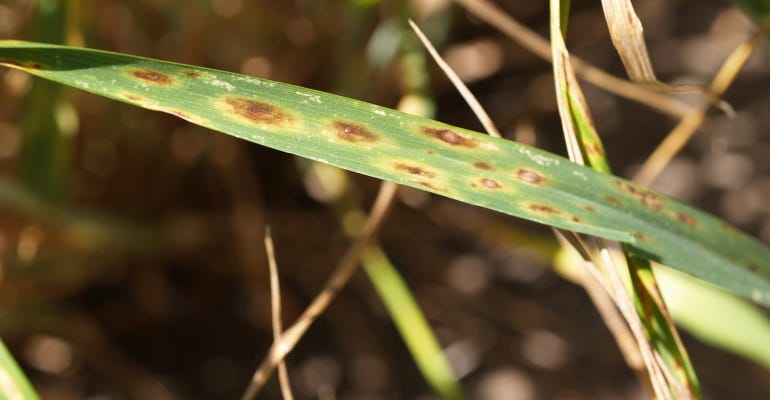May 1, 2019

By Stephen Wegulo
and Kyle Broderick
The wheat-growing season in Nebraska has started. Although the wheat crop still is in the early stages of development and diseases are minimal, regular scouting for early disease detection is recommended.
Scouting is especially important this season because of the excessive moisture we've had from the snow and major storms, as well as a wetter-than-normal weather outlook in late April and early May.
Scout the entire field or a representative area of the field once every 7 to 10 days using one of several patterns, for example X, W or Z, to walk through the field. Make frequent stops to examine plants for disease symptoms in the upper- and lower-crop canopy.
If you observe stunting, pull a few plants and examine the crown and roots for discoloration or rotting, which is a symptom of root or crown rot caused by soilborne fungal pathogens.

SYMPTOMS SHOWING UP: Tan spot is a common problem for wheat growers in Nebraska. Symptoms first appear as small, tan, diamond-shaped spots that progress to elliptical to elongate tan-colored spots with a dark brown center and yellow border.

Other symptoms to look for are:
• fungal leaf spots indicative of Septoria tritici blotch or tan spot, stripe rust and leaf rust pustules,
• powdery mildew, general yellowing that may be because of nutrient deficiencies,
• yellowing from the leaf tip down indicative of barley yellow dwarf virus,
• and a mosaic of yellow and green on leaves indicative of wheat streak mosaic or wheat soilborne mosaic.
Samples can be mailed to the Plant and Pest Diagnostic Clinic for accurate disease identification and management recommendations. Instructions for submitting samples to the clinic can be found at the University of Nebraska-Lincoln's CropWatch site.
Examination of recent wheat sample submissions to the clinic revealed virus symptoms — and a double infection by wheat streak mosaic virus and wheat soilborne mosaic virus was confirmed in one sample. Although symptoms of these two virus diseases are similar (stunting and a mosaic of yellow and green on the leaves), the two diseases are quite different in their life cycles and management.
Wheat streak mosaic virus is transmitted by wheat curl mites that are transported by wind from infested volunteer wheat or late-maturing host crops such as corn to newly emerged wheat in the fall.
Mites also can be dispersed in spring from infested wheat fields, but infections that occur in fall are the most damaging. Symptoms of wheat streak mosaic in early spring are an indication that infections occurred in the fall.
Management of wheat streak mosaic includes controlling volunteer wheat before planting in the fall, avoiding early planting, planting resistant or tolerant varieties, and avoiding planting near late-maturing mite and virus host crops such as corn and foxtail millet.
Wheat soilborne mosaic virus, on the other hand, is transmitted by a primitive soilborne organism in the Kingdom Protozoa known as Polymyxa graminis that is favored by excessive soil moisture.
Zoospores (asexually produced spores capable of swimming in water) of P. graminis infect the roots of wheat seedlings in the fall during cool, wet periods. These infections result in severe stunting and yellowing in early spring. These symptoms tend to be most conspicuous in low-lying areas of the field.
Wheat soilborne mosaic can be managed by planting resistant varieties and avoiding planting in low areas in the field where drainage is poor.
Wheat variety ratings for wheat streak mosaic and wheat soilborne mosaic are available in the 2018 Fall Seed Guide.
Update from Southern states
Wheat soilborne mosaic also has been observed in Kansas. Stripe rust and leaf rust were found in south-central Kansas and have been reported in Southern states, including Texas and Oklahoma.
Because it is still early in the wheat-growing season, it is most likely that these rust diseases will occur in Nebraska wheat fields.
Fungal leaf spots, stripe rust, leaf rust and powdery mildew can be controlled by planting resistant varieties, applying a fungicide timed to protect the flag leaf and rotating crops (for fungal leaf spots and powdery mildew).
Wegulo is a Nebraska Extension plant pathologist, and Broderick is an Extension educator and coordinator of the University of Nebraska-Lincoln Plant and Pest Diagnostic Clinic.
This report comes from UNL CropWatch, which is solely responsible for the information provided and is wholly owned by the source. Informa Business Media and all its subsidiaries are not responsible for any of the content contained in this information asset.
You May Also Like




